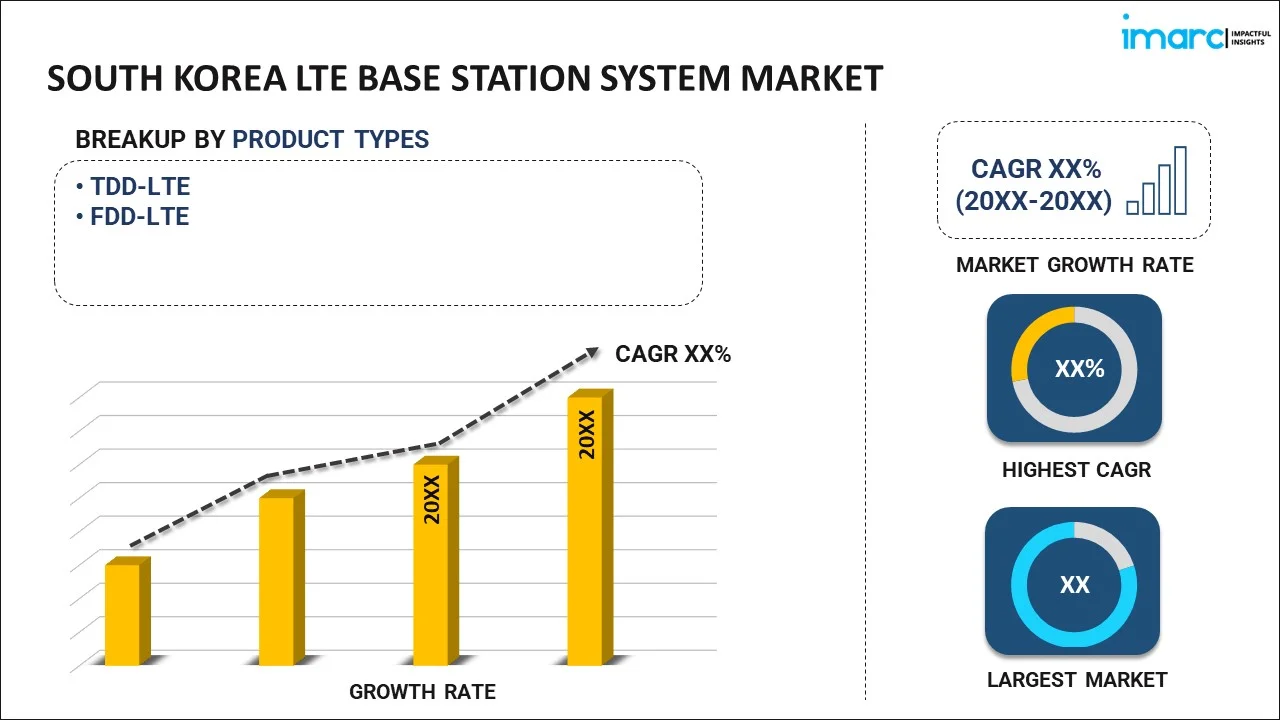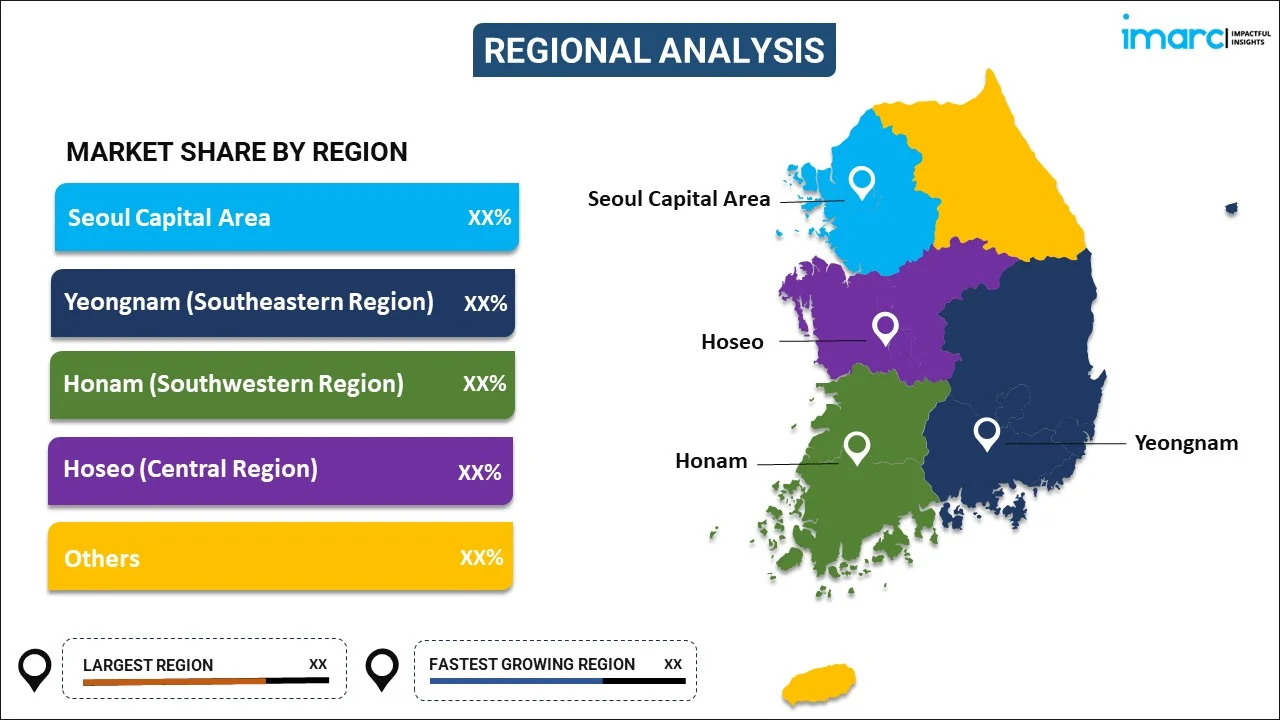
South Korea LTE Base Station System Market Report by Product Type (TDD-LTE, FDD-LTE), End User (Residential and Small Office or Home Office (SOHO), Enterprise, Urban, Rural), and Region 2024-2032
Market Overview:
South Korea LTE base station system market size is projected to exhibit a growth rate (CAGR) of 22.30% during 2024-2032. The increasing demand for high-speed mobile communication, government initiatives to upgrade infrastructure, ongoing technological advancements, and significant growth in the electronics industry are the major factors stimulating the market growth.
|
Report Attribute
|
Key Statistics
|
|---|---|
|
Base Year
|
2023 |
|
Forecast Years
|
2024-2032
|
|
Historical Years
|
2018-2023
|
| Market Growth Rate (2024-2032) | 22.30% |
Long-term evolution (LTE) base station system is a fundamental component of modern wireless telecommunications networks. Its primary function is to facilitate wireless communication between user devices, such as smartphones, tablets, and the Internet of Things (IoT) devices, and the core network infrastructure. The system operates by utilizing radio frequencies to transmit and receive data, voice, and multimedia content. LTE base stations employ a combination of advanced technologies, including multiple antennas, signal processing, and efficient modulation schemes, to provide users with high-speed and reliable wireless connectivity. They work on the principle of cellular communication, wherein a geographic area is divided into smaller regions called cells. Each cell is served by an individual base station, and as users move within the network, they are handed off seamlessly from one cell to another. This ensures continuous connectivity and optimal network performance. The LTE base station communicates with user devices through radio waves, and data is transmitted in digital packets, which are then decoded and processed at both ends of the connection. They offer high data transfer rates, enabling users to enjoy bandwidth-intensive applications such as video streaming and online gaming. They also provide low latency, reducing the time delay in data transmission and improving the overall user experience, especially for real-time applications. Additionally, LTE base stations are energy-efficient, leading to longer battery life for mobile devices.
South Korea LTE Base Station System Market Trends:
The South Korea LTE base station system market is influenced by several key drivers, such as the increasing demand for high-speed and reliable mobile communication services. South Korea is known for its tech-savvy population, which constantly seeks faster and more efficient mobile data services. In line with this, the government's initiatives to expand and upgrade the country's telecommunications infrastructure have played a pivotal role in bolstering the market growth. These initiatives include investments in fifth-generation (5G) technology, which requires the deployment of advanced LTE base station systems to support the network. Additionally, the continuous innovation in LTE technology, such as the development of more efficient and energy-saving base stations, has been a driving force in this market, which is stimulating the market growth. Moreover, the strong partnerships between telecom operators and equipment manufacturers are fostering the adoption of LTE base station systems, further favoring the market growth. Furthermore, the increasing adoption of IoT devices and smart technologies has led to a surge in data traffic, necessitating the expansion and enhancement of LTE base station systems to meet these demands, which is boosting the market growth in the country.
South Korea LTE Base Station System Market Segmentation:
IMARC Group provides an analysis of the key trends in each segment of the market, along with forecasts at the country level for 2024-2032. Our report has categorized the market based on product type and end user.
Product Type Insights:

- TDD-LTE
- FDD-LTE
The report has provided a detailed breakup and analysis of the market based on the product type. This includes TDD-LTE and FDD-LTE.
End User Insights:
- Residential and Small Office or Home Office (SOHO)
- Enterprise
- Urban
- Rural
A detailed breakup and analysis of the market based on the end user have also been provided in the report. This includes residential and small office or home office (SOHO), enterprise, urban, and rural.
Regional Insights:

- Seoul Capital Area
- Yeongnam (Southeastern Region)
- Honam (Southwestern Region)
- Hoseo (Central Region)
- Others
The report has also provided a comprehensive analysis of all the major regional markets, which include Seoul Capital Area, Yeongnam (Southeastern Region), Honam (Southwestern Region), Hoseo (Central Region), and Others.
Competitive Landscape:
The market research report has also provided a comprehensive analysis of the competitive landscape in the market. Competitive analysis such as market structure, key player positioning, top winning strategies, competitive dashboard, and company evaluation quadrant has been covered in the report. Also, detailed profiles of all major companies have been provided.
South Korea LTE Base Station System Market Report Coverage:
| Report Features | Details |
|---|---|
| Base Year of the Analysis | 2023 |
| Historical Period | 2018-2023 |
| Forecast Period | 2024-2032 |
| Units | US$ Million |
| Scope of the Report | Exploration of Historical and Forecast Trends, Industry Catalysts and Challenges, Segment-Wise Historical and Predictive Market Assessment:
|
| Product Types Covered | TDD-LTE, FDD-LTE |
| End Users Covered | Residential and Small Office or Home Office (SOHO), Enterprise, Urban, Rural |
| Regions Covered | Seoul Capital Area, Yeongnam (Southeastern Region), Honam (Southwestern Region), Hoseo (Central Region), Others |
| Customization Scope | 10% Free Customization |
| Report Price and Purchase Option | Single User License: US$ 3699 Five User License: US$ 4699 Corporate License: US$ 5699 |
| Post-Sale Analyst Support | 10-12 Weeks |
| Delivery Format | PDF and Excel through Email (We can also provide the editable version of the report in PPT/Word format on special request) |
Key Questions Answered in This Report:
- How has the South Korea LTE base station system market performed so far and how will it perform in the coming years?
- What has been the impact of COVID-19 on the South Korea LTE base station system market?
- What is the breakup of the South Korea LTE base station system market on the basis of product type?
- What is the breakup of the South Korea LTE base station system market on the basis of end user?
- What are the various stages in the value chain of the South Korea LTE base station system market?
- What are the key driving factors and challenges in the South Korea LTE base station system?
- What is the structure of the South Korea LTE base station system market and who are the key players?
- What is the degree of competition in the South Korea LTE base station system market?
Key Benefits for Stakeholders:
- IMARC’s industry report offers a comprehensive quantitative analysis of various market segments, historical and current market trends, market forecasts, and dynamics of the South Korea LTE base station system market from 2018-2032.
- The research report provides the latest information on the market drivers, challenges, and opportunities in the South Korea LTE base station system market.
- Porter's five forces analysis assist stakeholders in assessing the impact of new entrants, competitive rivalry, supplier power, buyer power, and the threat of substitution. It helps stakeholders to analyze the level of competition within the South Korea LTE base station system industry and its attractiveness.
- Competitive landscape allows stakeholders to understand their competitive environment and provides an insight into the current positions of key players in the market.
Need more help?
- Speak to our experienced analysts for insights on the current market scenarios.
- Include additional segments and countries to customize the report as per your requirement.
- Gain an unparalleled competitive advantage in your domain by understanding how to utilize the report and positively impacting your operations and revenue.
- For further assistance, please connect with our analysts.
 Inquire Before Buying
Inquire Before Buying
 Speak to an Analyst
Speak to an Analyst
 Request Brochure
Request Brochure
 Request Customization
Request Customization




.webp)




.webp)












